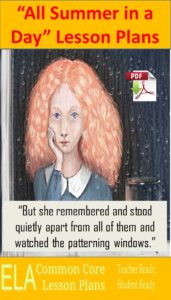It had been raining insults for seven years; thousand upon thousands of days compounded and filled from one end to the other with insults, with the drum and gush of criticism, with the sweet crystal fall of back-handed compliments and the concussion of expletives so heavy they were tidal waves of sadness come over the teachers’ lounge. A thousand lesson plans had been crushed under the red pen and grown up a thousand times to be crushed again. And this was the way life was forever at Venus High School, and this was the schoolroom of the children of the teacher who needed “All Summer in a Day” lesson plans.
I got you covered with this “All Summer in a Day” lesson plan on imagery: All Summer in a Day Interpreting Sensory Details Lesson Plan.
“All Summer in a Day” Lesson Plans and Ideas

These “All Summer in a Day” lesson plans are ready to use. All you need is a printer and a copy machine. There’s no additional prep and you will be set for the week. The “All Summer in a Day” unit plan contains lesson plans, graphic organizer handouts with answer keys, essay rubrics, a summary and analysis of the story, discussion ideas, a quiz, and more. Lessons focus on symbolism, theme, conflict, setting, imagery, characterization, literary analysis, and more.
Those who prefer to go in depth with their teaching will benefit from additional lesson plans. The “All Summer in a Day” Lesson Plans Unit contains 8 lesson plans (some on the subjects below), answer keys, and a quiz.
- Symbolism. The key symbol in the story is the sun. Look at it in more detail.
- Discuss theme in “All Summer in a Day.” Trace the changes experienced by the mob (the children) to ascertain themes in “All Summer in a Day.”
- Imagery and Sensory Details. Focus on Bradbury’s description of the sun and of the rain. Use the included pdf: All Summer in a Day Interpreting Sensory Details Lesson Plan.
- The story’s setting contributes greatly to the conflicts experienced by the children.
- Plot. A simple story map helps students recognize the elements of a short story.
- Making Personal Connections. There’s a good chance students relate to both Margot and her remorseful tormentors on some level.
“All Summer in a Day” Summary
It always rains on Venus…well not always. Every seven years the sun comes out for an hour or two. And today is the day. The children are skeptical. Margot is not. This is just one more reason the children hate Margot. Other reasons include her differentness—she won’t play games with them; she screams in the shower—things like that.
There’s a rumor Margot gets to return to Earth. That’s one more reason the children don’t like her. And she remembers the sun from when she was there. She has only been on Venus since she was 4. The other children were born on Venus. The children are sick of Margot.
So they lock her in a closet.
The teacher comes back in the room and leads the class outside to enjoy the sun. And do they ever enjoy the sun! One of the students feels a raindrop and starts to cry. Then comes the lightning and thunder. Everyone hurries back in the classroom.
They remember Margot. They’re all like, “Oh sh%t! We forgot about Margot.” They feel really, really bad and walk down to the closet where they had imprisoned her.
 “All Summer in a Day” Setting
“All Summer in a Day” Setting
I could just write “Venus” here and my “All Summer in a Day” setting requirement would be taken care of, but there’s a little more to it than that. You see, it’s the weather on Venus that really distinguishes the setting.
It rains. A lot.
The story’s theme, however, could take place on any planet. In any country. In any city. It’s the plight and mistreatment of the outsider. It’s the lack of empathy and understanding of those who are different, of those we don’t understand. So don’t think of the “All Summer in a Day” setting as Venus, necessarily. Think of it as your classroom, as your school, as your neighborhood.
Let’s all hold hands and sing “Kumbaya.”
Common Core Standards
In case you’re looking for lesson plans that cover these standards, I listed these two. You can tweak the assignment quite easily to cover more.
- RL Standard 1. Cite strong and thorough textual evidence to support analysis of what the text says explicitly as well as inferences drawn from the text.
- RL Standard 2. Determine a theme or central idea of a text and analyze in detail its development over the course of the text, including how it emerges and is shaped and refined by specific details; provide an objective summary of the text.
- RL Standard 4. Determine the meaning of words and phrases as they are used in the text, including figurative and connotative meanings; analyze the cumulative impact of specific word choices on meaning and tone (e.g., how the language evokes a sense of time and place; how it sets a formal or informal tone).
Last Updated on August 8, 2018 by Trenton Lorcher
Share This:
